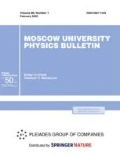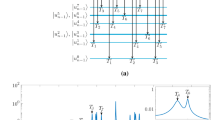Abstract
The model of a single multilevel one-electron atom with violated symmetry such that its transition dipole-moment operator has constant diagonal matrix elements, among which not all are pairwise equal to each other, has been studied. It has been shown that the expression for the far electromagnetic field of such an atom does not contain any appreciable contributions from the diagonal matrix elements of the transition dipole moment in an explicit form; thus, these matrix elements have an effect on fluorescence via the time dependence of non-diagonal matrix elements due to quantum non-linear processes of higher orders. It has also been demonstrated that a two-level quantum system, whose transition dipole operator has constant unequal diagonal matrix elements, can continuously fluoresce under excitation with monochromatic laser radiation at a much lower frequency than the frequency of the exciting radiation. The possibility of the experimental detection and practical application of this effect are discussed.
Similar content being viewed by others
References
M. O. Scully and M. S. Zubairy, Quantum Optics (Cambridge Univ. Press, 1997).
G. S. Agarwal, Quantum Statistical Theories of Spontaneous Emission and Their Relation to Other Approaches (Springer, Berlin, 1974).
R. J. Glauber, Quantum Theory of Optical Coherence (Wiley, Weinheim, 2007).
Z. Ficek and H. S. Freedhoff, Phys. Rev. A 48, 3092 (1993).
Z. Ficek and U. S. Freedhoff, Phys. Rev. A 53, 4275 (1996).
Z. Ficek, J. Seke, A. V. Soldatov, and G. Adam, Phys. Rev. A 64, 013813 (2001).
M. Lax, Phys. Rev. 172, 350 (1968).
C. W. Gardiner, Handbook of Stochastic Methods (Springer, Heidelberg, 1983).
H. Carmichael, An Open Systems Approach to Quantum Optics (Springer, Berlin, 1993).
B. R. Mollow, Phys. Rev. 188, 1969 (1969).
F. Schuda, C. R. Stroud, Jr., and M. Hercher, J. Phys. B 7, L198 (1974).
F. Y. Wu, R. E. Grove, and S. Ezekiel, Phys. Rev. Lett. 35, 1426 (1975).
W. Hartig, W. Rasmussen, R. Schieder, and W. Walther, Z. Phys. A 278, 205 (1976).
Author information
Authors and Affiliations
Corresponding author
Additional information
Original Russian Text © N.N. Bogolubov, Jr., A.V. Soldatov, 2018, published in Vestnik Moskovskogo Universiteta, Seriya 3: Fizika, Astronomiya, 2018, No. 2, pp. 31–39.
About this article
Cite this article
Bogolubov, N.N., Soldatov, A.V. Fluorescence in a Quantum System with Violated Symmetry. Moscow Univ. Phys. 73, 154–161 (2018). https://doi.org/10.3103/S0027134918020029
Received:
Accepted:
Published:
Issue Date:
DOI: https://doi.org/10.3103/S0027134918020029




